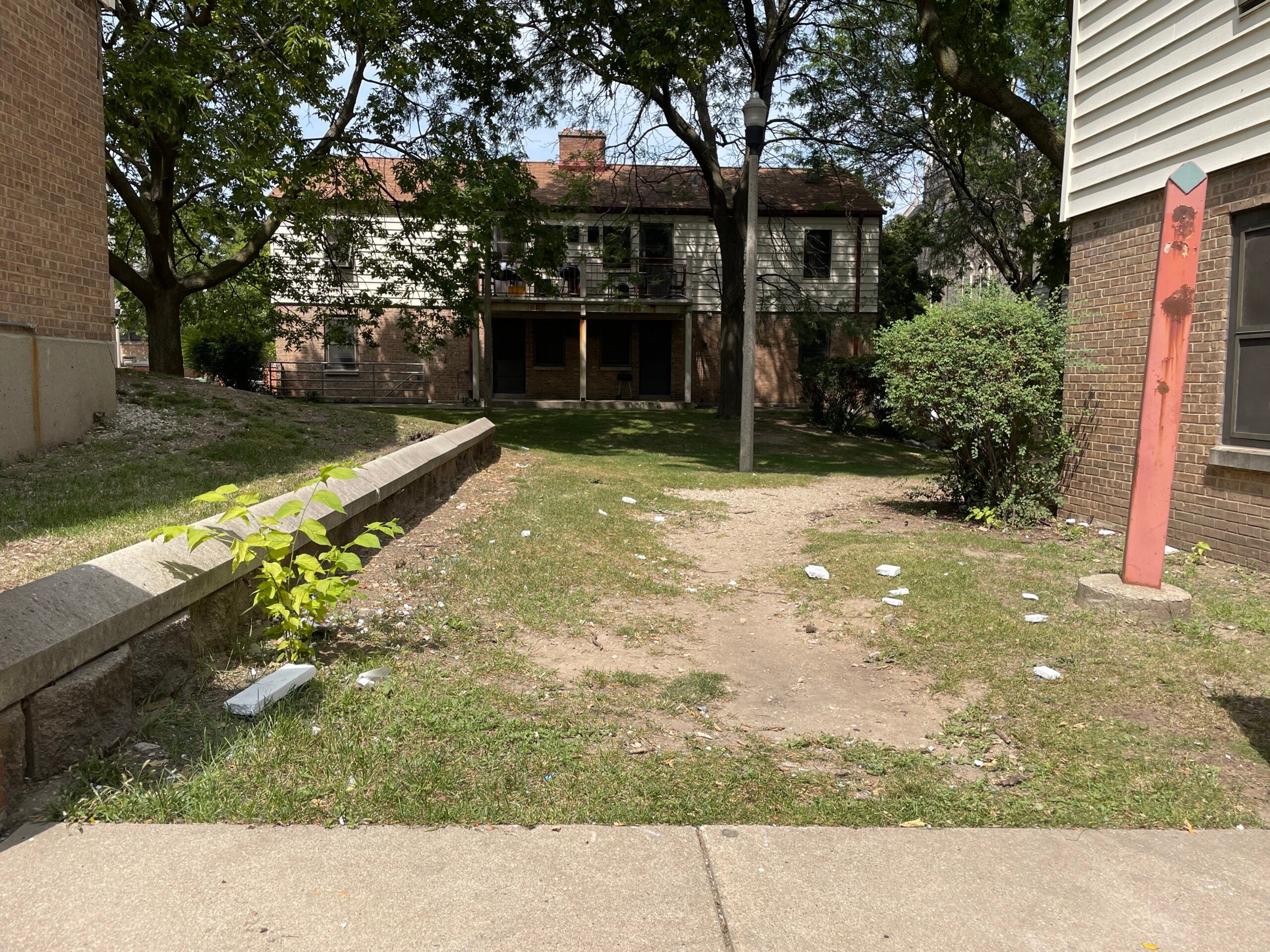Matrix Martinez spent months working extra hours at his job to save up money to move into his first apartment at the Community Within the Corridor development in Milwaukee in December.
“I put so much work into that apartment,” Martinez said.
But for the past three months, he’s been forced to live at a hotel after he and more than 150 other residents at the affordable apartment complex were evacuated based on an order from the Milwaukee Health Department. The evacuation order came after the Wisconsin Department of Natural Resources reported that tests revealed “exceptionally high” levels of trichloroethylene, or TCE, at the complex.
Stay informed on the latest news
Sign up for WPR’s email newsletter.
“It’s been three months,” Martinez said. “I’ve been depressed, I’ve been having anxiety and, you know, I’ve been just stuck.”
Shortly after he moved in, Martinez said he began experiencing headaches so bad that at times he could hardly move. He believes the headaches were tied to the elevated levels of TCE, a cancer-causing chemical. Even though the headaches have stopped since he moved out, he’s now dealing with new worries about next steps to take regarding his living situation.
He’s not alone — many other residents have been forced to find temporary housing, while asking questions about when, or if, they’ll be able to move back into their apartments.

The developers for the complex recently offered residents a $5,000 voluntary termination agreement for living expenses in exchange for signing off on a pledge not to sue the developers in the future. Residents have until June 23 to sign that agreement, and until July 14 to vacate. Management is paying for hotel accommodations and food and transportation stipends until July 14.
The DNR says testing at the complex could take several months to finish.
Meanwhile, a lawsuit filed on behalf of one resident claims the developers failed to notify residents of the presence of the chemical at the east block of the development.
A statement from the development firms Scott Crawford Inc. and Roers Companies said their goal has “always been to safely return residents to their homes as quickly as possible while addressing the needs of those affected.”
“CWC has refunded past rent paid for displaced residents, waived all new rent charges, provided hotel accommodations and housing stipends, provided daily food stipends, and reimbursed transportation expenses while renters have been out of their homes,” that statement said.
More testing needs to be completed before residents can move back in
A June letter to residents from the DNR said the developers must perform a cleanup of the contamination, install a system to prevent indoor air contamination and collect data that shows that system is working. The DNR said data collection on the site will need to take place in the winter, when the heat is running, meaning residents may not be able to move back into the building for several months.
“It is a generally accepted scientific principle that the concentrations of contaminants in indoor air due to vapor intrusion can vary significantly over time, and the potential for contaminated vapor entering the building is greatest during the winter heating months,” the letter stated.
There isn’t a specific timeline yet for how long that work could take because of the level of TCE in the soil and the “structural complexity” of the building, a complex of new apartments built in a renovated former Briggs and Stratton factory. TCE is a commonly used solvent that is used for degreasing metal parts by industry. It doesn’t break down easily in the environment.
Vapor mitigation systems are used in buildings where chemical vapors from contaminated soil and groundwater may be inhaled by indoor occupants, according to the United States Environmental Protection Agency.

Part of the cleanup process at the site also includes completing building modifications, such as “sealing sump pumps, cracks, holes, and other points of vapor entry,” and removing contaminated building materials, the DNR said.
The EPA has classified TCE as a known carcinogen, and there’s strong evidence linking exposure to kidney and liver cancers. The DNR also said long-term or repeated exposure to TCE at high levels could impact the liver and kidney and have immune and Lymphatic System effects. It could also lead to miscarriages for those who are pregnant.
“The effects on fetal heart development can occur early in pregnancy, sometimes before a woman may know she is pregnant,” the DNR letter stated.
In March, the DNR received air test results that showed TCE readings beyond the indoor action level of 2.1 micrograms per cubic meter at 19 spots within residential and common spaces. The highest level recorded was 400 micrograms per cubic meter.
A statement from the city of Milwaukee Health Department said they’re priority is on the “health and safety of the residents.”
“To protect the health of all CWC residents, our responsibility and role in this situation is to uphold the health order until environmental experts determine corrective actions have been taken by the development company and recommended testing has been completed to successfully demonstrate the property is safe for habitation,” the statement said.
A statement from the developers also said management at the property has been working with residents to retrieve their belongings, as well to help transition residents into long-term housing.
“This situation has been and continues to be a frustrating experience for all the impacted residents. We share their disappointment that they will be unable to return home in a reasonable timeframe,” the statement said.
Lawsuit claims developers failed to notify residents of the chemical
Milwaukee-based attorney Michael Cerjak filed a lawsuit on behalf of resident Tiffany Bowen, claiming management failed to disclose conditions that “represented a substantial hazard and unreasonable risk of injury” to Bowen and other residents. The lawsuit explains that Bowen started to get headaches and feel dizzy and nauseous shortly after she moved in.
“She felt awful and called for paramedics twice. She was transferred to the emergency department, where health care providers had difficulty diagnosing her,” the lawsuit said.
Bowen’s son also experienced similar symptoms. Bowen also left behind medications and many of her items in her apartment after having only 30 minutes to leave when the evacuation order was put in place.
Cerjak said the lawsuit will soon be amended to add more residents.
“They (residents) moved into a building that they thought was going to be safe and secure,” Cerjak said. “After a short time, they had to evacuate with no notice, they had to get out. They still don’t have their things. They’ve been living in hotel to hotel, and I think it’s caused a great deal of stress on a lot of families.”
Cerjak said he believes residents should have a choice whether to pursue litigation against the developers or sign the termination agreement.
“Further adding to this crisis is the fact that many of the displaced Community (Within the Corridor) residents are on public assistance and, on information and belief, there is a shortage of low–income housing available, like the Community development, where these residents can transition to on short notice,” the lawsuit said.
The lawsuit said the fact that the termination agreement would block residents from suing the company in the future is troubling, as residents could develop health problems in the coming months and years because of exposure to the dangerous chemical.
Presence of TCE was seen at site several years earlier, lawsuit claims
The site was once occupied by a Briggs and Stratton factory and was used to manufacture engines. In 2001, the DNR was notified of environmental contamination at the site. In 2008, the site was closed with land-use limitations because of the contamination, the lawsuit said. But testing performed on the site in Nov. 2020 showed that there was still TCE present on the site.
Residents began moving into part of the affected building last winter after it received an occupancy certificate from the city of Milwaukee in December. Some people had already begun moving into another portion of the building as early as October under a separate occupancy certificate.

“Ongoing testing performed until December 2022 confirmed the ongoing presence of TCE,” the lawsuit said.
The developers did install a vapor mitigation system in the building to remove airborne chemicals on the site. They also submitted a vapor mitigation plan in January, but the DNR rejected those plans, and “strongly recommended” that the developers complete all rounds of testing before any residents move in.
The lawsuit states the DNR had “repeatedly, and strongly, recommended in writing a number of times that the building not be occupied until developers completed several rounds of commissioning and testing.”
Shane LaFave, senior vice president of development for Roers Companies, told Wisconsin Public Radio in March that the DNR’s recommendation would mean the last round of air testing would take place in August, which indicated an eight-month delay. He said they were trying to balance the demand for affordable housing after receiving more than 4,000 inquiries from prospective residents in October.
The DNR made multiple requests of the companies’ consultant, K. Singh & Associates, to determine whether the building was occupied before learning of the elevated levels.
“East Block has some occupancy. We are working on taking corrective measures. We will keep you posted,” wrote K. Singh CEO Pratap Singh in a March 22 email.
The next day, the DNR received the first round of air sampling that showed elevated levels, and the consultant confirmed women of child-bearing age were living in the apartment building.
The statement from the developers said they could not comment on the lawsuit because it’s an active case.
“We immediately began implementing additional remediation and testing activities when March’s commissioning results revealed elevated TCE vapor levels in areas within the building, and those efforts have continued ever since,” a statement from the developers said.
Wisconsin Public Radio, © Copyright 2025, Board of Regents of the University of Wisconsin System and Wisconsin Educational Communications Board.





